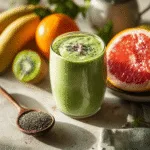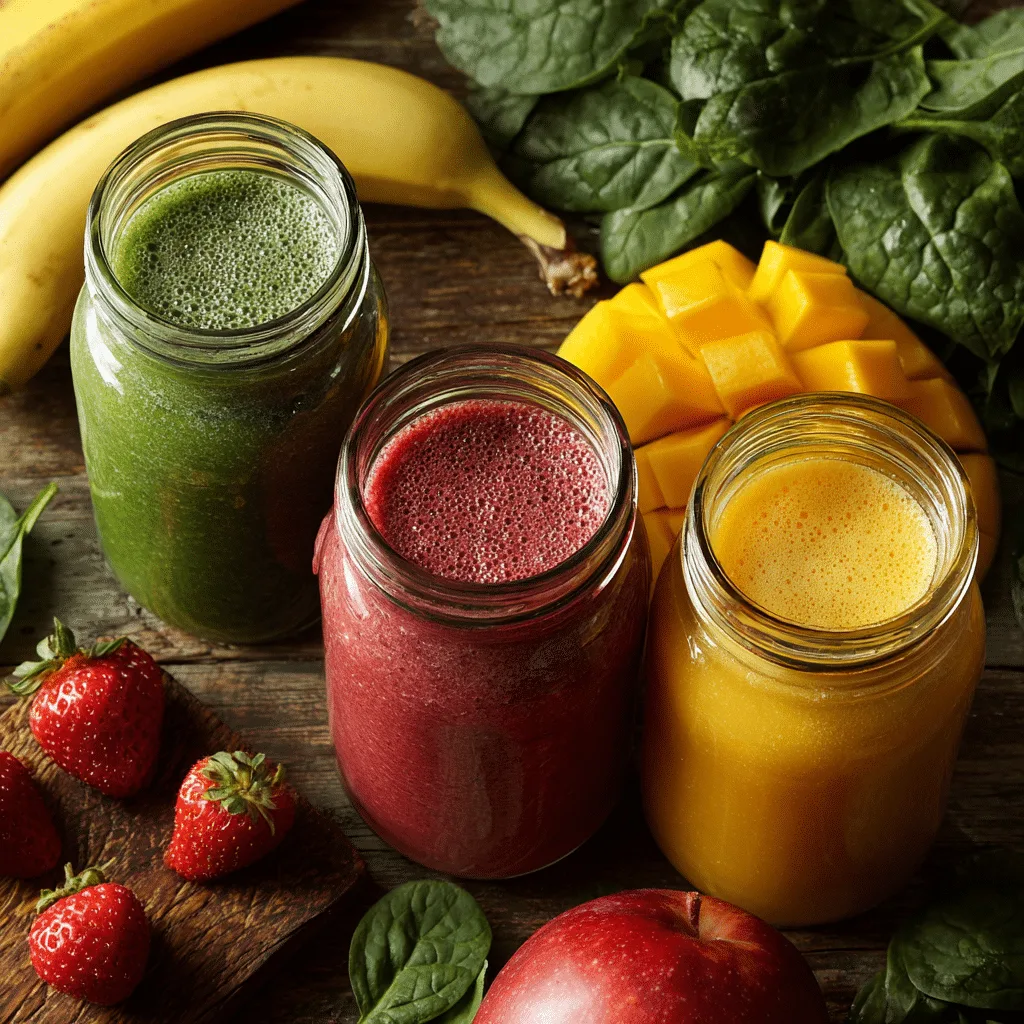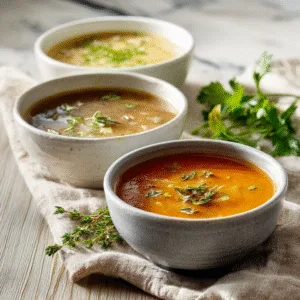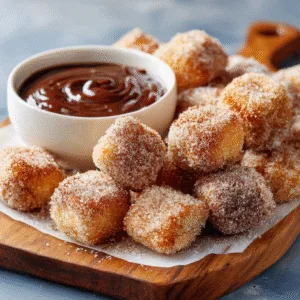Smoothies are one of the easiest and most satisfying ways to dive into healthy eating—even if you’re brand new to the blender game. This guide to beginner smoothie recipes will show you how to whip up delicious blends in just minutes using a few simple, affordable ingredients. Whether you’re craving a fruity burst, a creamy protein boost, or a sneaky way to get more greens into your day, these beginner smoothie recipes are designed with total beginners in mind. Plus, you’ll discover make-ahead freezer tips, the perfect smoothie formula, and expert blending hacks to make every morning easier. Let’s blend, pour, and sip your way into the wonderful world of beginner smoothie recipes.
Table of Contents
Table of Contents

Why Beginner Smoothie Recipes Are the Perfect Starting Point
From My Kitchen Window to Yours: A Real Beginner’s Start
Hi, I’m Amanda—and trust me, if there’s one thing I wish I’d had when I started my journey toward better breakfasts, it’s a list of simple, no-fuss beginner smoothie recipes. I remember my first attempt vividly: a too-thick mess of frozen banana, peanut butter, and…tap water. My blender whirred like it was choking. But over time, I learned that you don’t need a fancy juicer, ten superfoods, or Instagram-worthy layering skills. You just need balance, a few fresh ingredients, and a formula that works. That’s what these beginner smoothie recipes are all about.
These days, my mornings start with something I can whip up with whatever fruit I have lying around—often while dodging my golden retriever and answering my teen’s “what’s for breakfast?” questions. Most days, I go back to my favorite beginner green smoothie: spinach, banana, and almond milk. It’s simple, vibrant, and never lets me down.
By using a basic ratio—1 part fruit, 1 part liquid, plus optional extras—you can make endless variations that suit your tastes, budget, and pantry. This guide includes a mix of tried-and-true favorites and quick hacks that’ll have you feeling confident with your blender from day one.
If you’re looking for even more kitchen starters, check out our easy 30-minute dinner recipes or healthy breakfast bowls for more quick meal inspiration.
Print
Beginner Smoothie Recipes That Are Quick, Creamy, and Healthy
- Total Time: 3
- Yield: 1 serving 1x
- Diet: Vegan
Description
A creamy and quick beginner smoothie recipe using just 3 ingredients: banana, frozen berries, and almond milk—perfect for busy mornings.
Ingredients
- 1 ripe banana
- 1 cup frozen mixed berries
- 1 cup unsweetened almond milk
Instructions
- Add almond milk to the blender.
- Peel and add banana.
- Add frozen berries on top.
- Blend until smooth.
- Pour and serve immediately.
Notes
Use frozen banana for a thicker texture.
Substitute oat milk or soy milk if preferred.
Add chia seeds or oats for extra nutrition.
- Prep Time: 3
- Category: Breakfast
- Method: Blending
- Cuisine: American
Nutrition
- Serving Size: 1 glass
- Calories: 180
- Sugar: 12g
- Sodium: 75mg
- Fat: 2g
- Saturated Fat: 0g
- Unsaturated Fat: 2g
- Trans Fat: 0g
- Carbohydrates: 34g
- Fiber: 5g
- Protein: 3g
- Cholesterol: 0mg
Beginner Smoothie Recipes with Simple Formulas
The 1-1-1 Formula Every Beginner Should Know
When it comes to beginner smoothie recipes, the most empowering tip I can give you is to stop overcomplicating things. You don’t need a shelf full of powders or a long grocery list. Most beginner smoothies follow one golden rule: the 1-1-1 ratio. That means one cup of fruit, one cup of liquid, and one optional add-in like yogurt, oats, or nut butter. This basic combo makes nearly any smoothie taste amazing.
Here’s a quick breakdown:
- Fruit gives sweetness and texture. Bananas, frozen berries, pineapple, or mango are great beginner choices.
- Liquid thins the smoothie so it blends easily—go for water, almond milk, dairy milk, or coconut water.
- Extras like yogurt or chia seeds add protein and creaminess without much effort.
Don’t stress if your measurements aren’t exact. Smoothies are forgiving, which is why they’re perfect for beginners. And if you like structure, we’ve created an entire smoothie flavor guide that walks you through combinations that always work.
Quick 3-Ingredient Smoothies to Keep On Repeat
On busy mornings, I swear by 3-ingredient beginner smoothie recipes. They’re fast, satisfying, and totally doable—even with one eye open. Here are a couple of my favorites:
- Banana + Greek Yogurt + Almond Milk: Creamy and protein-packed.
- Frozen berries + Oats + Water: Heartier than you’d expect.
- Pineapple + Coconut Milk + Spinach: A tropical twist with hidden greens.
Want something even easier? Try our frozen smoothie packs guide that lets you prep a week’s worth of smoothies in 10 minutes flat.
By keeping the ingredients minimal and the steps short, you can build your confidence without the overwhelm. Trust me—these beginner smoothie recipes will make your mornings easier, tastier, and way less stressful.

Beginner Smoothie Recipes with Hidden Greens
Sneaky Greens for Smoothies That Don’t Taste “Healthy”
Green smoothies often scare off beginners—and I get it. Nobody wants their breakfast to taste like a salad. But trust me, beginner smoothie recipes can include greens without that “earthy” aftertaste. The trick? Pair mild greens like spinach with strong, sweet fruits such as banana, pineapple, or mango.
Here’s a simple rule: start with a handful of spinach, not kale. Spinach has a neutral flavor and blends down effortlessly, even with a basic blender. Combine it with half a frozen banana, one cup of almond milk, and a few chunks of mango, and you’ve got a beginner green smoothie that tastes like a tropical vacation.
Even my teenager, who turns his nose up at most vegetables, loves this combo—and he has no idea it’s packed with iron, fiber, and antioxidants.
You can find more flavor-balanced recipes like this in our kid-approved smoothies section, which includes options for picky eaters and lunchbox-safe blends.
Anti-Inflammatory and Energizing Green Combos
Once you’re comfortable tossing greens into your blender, you’ll want to explore a few beginner-friendly functional smoothies. One of the best is a green smoothie with spinach, banana, pineapple, and chia seeds. It’s bright, subtly sweet, and naturally anti-inflammatory thanks to the pineapple enzymes and omega-3-rich seeds.
Another favorite: kale + orange + frozen banana. The citrus cuts the bitterness of the kale while the banana brings the creamy texture you want. Add a little water or coconut water and blend away.
For more functional recipe ideas, head to our anti-inflammatory recipe archive and plant-based smoothies section—perfect for experimenting once you’ve mastered the basics.
These beginner smoothie recipes prove you can drink your greens and love them, no grimaces required.
Beginner Smoothie Recipes You Can Prep Ahead
Freezer Smoothie Packs for Fast, No-Stress Mornings
One of the biggest time-saving tips I’ve learned as a mom and meal-prep enthusiast is the magic of make-ahead smoothie packs. For anyone trying beginner smoothie recipes, this is a game changer. You prep everything in advance, stash it in the freezer, and dump it into the blender when you’re ready to go.
Start with reusable freezer-safe bags or glass containers. Then follow this simple method:
- Add 1 cup of frozen fruit (like strawberries, mango, or banana slices)
- Toss in a handful of spinach or kale
- Drop in extras like chia seeds or nut butter (optional)
- Label each pack with what liquid to add (usually 1 cup milk, water, or juice)
When morning comes, dump the frozen contents into your blender, add the liquid, and blend. Done in under a minute.
You can grab printable labels and recipe combinations in our meal prep smoothie toolkit, along with ideas for freezer-friendly snacks to pair with them.
Storage Tips and Flavor Preservation Tricks
Worried about freezer burn or soggy texture? Here’s the trick: freeze your leafy greens flat and use frozen fruit instead of fresh. Frozen ingredients also help create that thick, creamy consistency beginner smoothie recipes are known for—without the need for extra ice.
To preserve flavor, always store your packs in airtight bags and squeeze out any extra air before sealing. Don’t include liquids in the pack, as they’ll cause freezer crystals. Add those right before blending.
Want even more guidance on building a beginner-friendly prep routine? Don’t miss our smoothie starter checklist, which includes shopping lists, blender guides, and more.
Freezer smoothie packs are the simplest way to stay consistent with your nutrition goals—even when life gets messy.

Beginner Smoothie Recipes with Superfood Boosts
Easy Superfoods You Already Have in Your Pantry
Once you’ve mastered a few basic beginner smoothie recipes, it’s natural to want a little more from each blend—more energy, more nutrition, more staying power. The good news? You don’t need anything exotic or expensive. Superfoods can be as simple as the oats in your cupboard or the nut butter in your fridge.
Here are a few pantry staples perfect for boosting beginner smoothie recipes:
- Chia seeds: Just one tablespoon adds fiber, omega-3s, and thickness
- Rolled oats: Blend better when soaked for 5 minutes in milk or water
- Nut butters: Add healthy fat and protein with just a spoonful
- Flaxseed: Ground flax offers omega-3s and helps with digestion
You can rotate these based on what you have or your nutritional needs. They’re perfect for busy mornings when you need your smoothie to hold you over until lunch. For more inspiration on building smoothies that satisfy, browse our energy-boosting recipes and plant-powered breakfasts.
Superfoods for Immune Support and Gut Health
If you’re looking to support immunity or digestion, a few beginner-friendly superfoods can make a big difference. Greek yogurt adds probiotics and protein. Avocado gives creaminess and heart-healthy fats. And if you’re feeling adventurous, a scoop of spirulina or a pinch of turmeric adds antioxidants without much flavor if paired correctly.
Try this combo: frozen mango, banana, almond milk, avocado, and a pinch of turmeric. It’s smooth, vibrant, and immune-supportive.
You’ll find more blends like this in our immune-boosting smoothie section and gut health series, especially designed with beginners in mind.
These small upgrades take beginner smoothie recipes to the next level—without making things complicated.
Beginner Smoothie Recipes You Can Customize Easily
Flavor Formulas for Endless Beginner-Friendly Combos
One of the best parts about beginner smoothie recipes is that once you learn the basic structure, you can mix and match to create flavors you genuinely love. And you don’t need to guess—use this simple flavor formula, inspired by food writer Anna Jones:
2 parts main fruit + 1 part accent flavor + 1–2 parts liquid + add-ins (optional)
Here’s how that looks in real life:
- Main fruits: banana, berries, mango, pineapple
- Accent flavors: cinnamon, citrus juice, ginger, vanilla, cocoa powder
- Liquids: almond milk, coconut water, dairy milk, oat milk
- Add-ins: oats, yogurt, seeds, protein powder
Try pairing banana and strawberry with a splash of vanilla and almond milk. Or mango and pineapple with a pinch of ginger and coconut milk. The formula ensures balance while giving you room to get creative—without weird surprises.
For those eager to build unique combos, explore our smoothie flavor pairing guide and creative breakfast drinks for seasonal ideas and easy substitutions.
Interactive Mix & Match: Choose, Blend, Enjoy
Here’s a fun way to make choosing your smoothie as easy as spinning a wheel:
- Pick your base: banana, mango, or peach
- Choose a secondary flavor: pineapple, blueberry, or orange
- Add a liquid: oat milk, coconut water, or dairy milk
- Pick one extra: oats, nut butter, or protein powder
You just made a perfectly balanced smoothie!
You’ll find printable cards and customizable smoothie charts in our blender beginner’s toolkit, along with a downloadable version of the formula for your fridge.
These flavor maps make it effortless to keep your beginner smoothie recipes fun, flavorful, and never repetitive.
Beginner Smoothie Recipes for Every Diet & Allergy Need
Allergy-Friendly Swaps That Taste Just as Good
One concern many people have with beginner smoothie recipes is food sensitivities. But whether you’re dairy-free, gluten-free, or nut-free, it’s incredibly easy to make smoothies that work for you. Start with these beginner-friendly swaps that keep the flavor, texture, and nutrition on point:
- Dairy-Free: Swap regular milk with oat, almond, soy, or coconut milk. Use coconut yogurt or soy yogurt in place of Greek yogurt.
- Nut-Free: Choose sunflower seed butter or tahini instead of almond or peanut butter. Oat milk is a great nut-free base.
- Gluten-Free: Use certified gluten-free oats if you’re adding them to your blend.
- Low-Sugar: Skip juice and stick with water or unsweetened milk alternatives. Add cinnamon or vanilla for flavor without sweetness.
For a deeper dive into allergy-safe smoothie ingredients, head to our dairy-free smoothie archive and nut-free recipe index—perfect if you’re meal-prepping for family or school.
Vegan, Keto, and Paleo Smoothie Options for Beginners
If you’re following a specific eating style like vegan, keto, or paleo, your smoothie game can still be strong. In fact, beginner smoothie recipes are easily adaptable with just a few swaps:
- Vegan: Use plant-based milks, fruits, leafy greens, nut butters, flaxseed, and plant-based protein powder.
- Keto: Choose low-carb fruits like berries, avocado, and unsweetened almond milk. Add MCT oil or almond butter for fats.
- Paleo: Stick with whole fruits, leafy greens, nut milk, and seeds. Avoid dairy, oats, and processed powders.
Looking for recipes to match your diet? Browse our vegan smoothie recipes, keto-approved blends, and paleo smoothie collection to get started.
These options make beginner smoothie recipes accessible, inclusive, and just as delicious—no matter your dietary goals.
Beginner Smoothie Recipes with Better Blending & Seasonal Swaps
Blender Tips Every Beginner Needs to Know
Let’s be honest—no one wants chunks of unblended spinach or frozen fruit pieces in their “smooth” smoothie. One of the biggest barriers for people trying beginner smoothie recipes is poor blending. But with just a few smart tips, your smoothies can go from gritty to glorious.
Start by layering your ingredients properly:
- Liquids go in first near the blades
- Greens and soft ingredients (banana, yogurt) next
- Frozen fruits and ice go in last on top
This method helps your blender create a vortex that pulls everything down evenly. Use the pulse setting first if your blender has one, then blend from low to high.
Also, don’t overload your blender with too many frozen items at once—especially if it’s a budget model. If it’s struggling, add a bit more liquid. That’s your blender asking for help.
If you’re in the market for a beginner-friendly blender, check out our best starter blender guide to find one that won’t break the bank or your patience.
Seasonal & Local Smoothie Ingredients on a Budget
Smoothies don’t have to be expensive—and using seasonal, local fruits and vegetables is one of the best ways to keep costs down while supporting your local farmers.
In spring, try fresh strawberries and spinach. Summer calls for juicy peaches, cantaloupe, or watermelon. Fall is perfect for apples, pears, and even steamed sweet potatoes in smoothies. Winter? Go for frozen blueberries, bananas, and citrus fruits like oranges and clementines.
Pro tip: buy in-season fruit in bulk and freeze it yourself in individual portions. It’s cheaper and lasts longer.
For more regional inspiration, browse our seasonal smoothie guide and budget-friendly blender meals.
Mastering these techniques and shopping smart makes your beginner smoothie recipes not only better tasting but more sustainable and affordable too.
FAQs – Beginner Smoothie Recipes
1. What are the best beginner smoothie recipes to start with?
The best beginner smoothie recipes are simple and require just a few ingredients. Start with a basic fruit smoothie: one banana, one cup of frozen berries, and one cup of almond milk. From there, try adding yogurt, oats, or spinach. These easy combinations help you build confidence and discover your personal taste preferences.
2. How do you make beginner smoothies creamy without dairy?
To make dairy-free beginner smoothie recipes creamy, use ingredients like frozen banana, avocado, or coconut yogurt. Plant-based milks like oat or almond milk also help achieve that rich texture. You can even add soaked chia seeds or nut butters for extra smoothness without any dairy at all.
3. Can I prep beginner smoothie recipes ahead of time?
Absolutely! One of the easiest ways to stay on track with smoothies is to create freezer smoothie packs. Just portion out your fruit, greens, and add-ins into freezer bags. When you’re ready to blend, pour in the liquid, blend, and go.
4. What blender should I use for beginner smoothie recipes?
You don’t need an expensive blender to make great beginner smoothie recipes. Look for one with a strong motor (at least 500 watts) and multiple speed settings. Personal-size blenders like the NutriBullet or Ninja are great for single servings.




